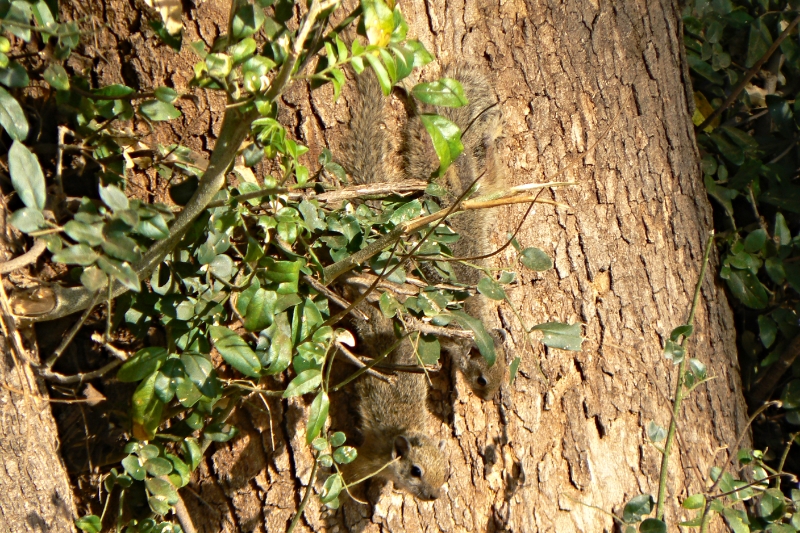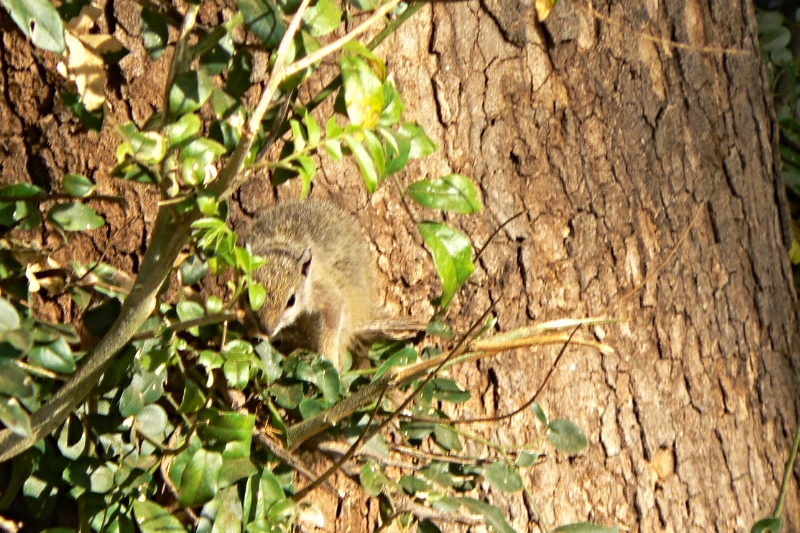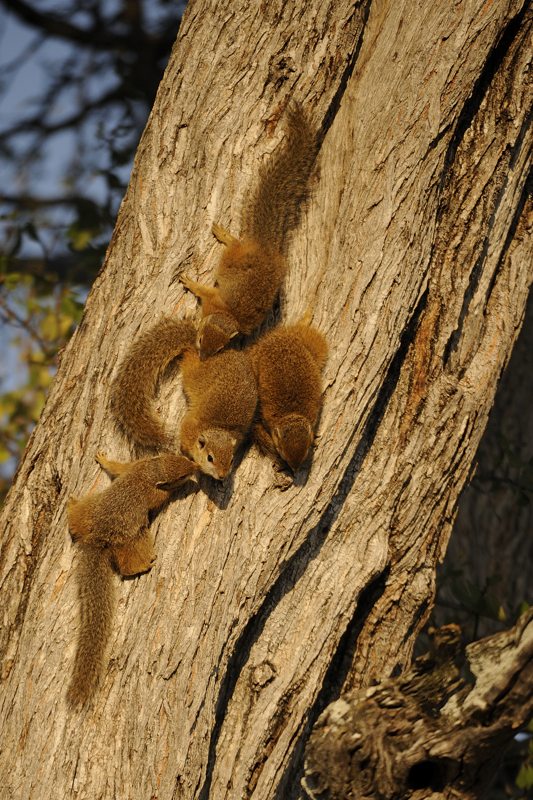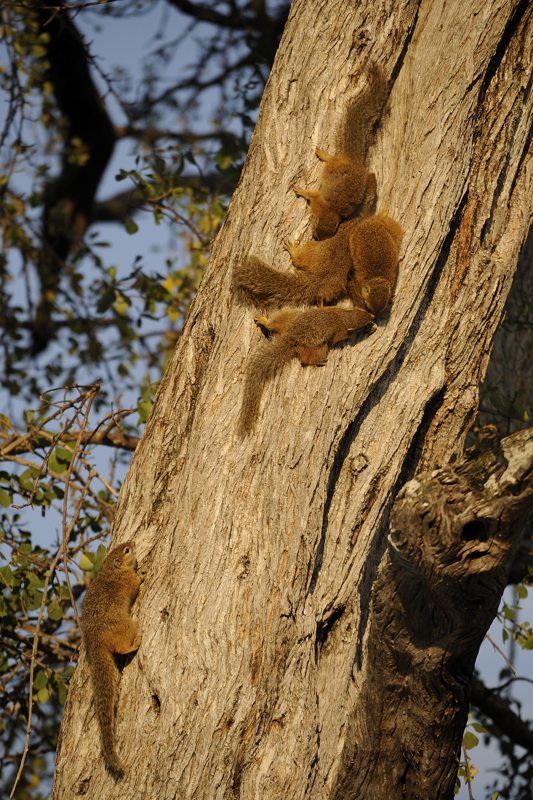In South Africa we have the Cape Ground Squirrel (Xerus inauris)
At the entrance of a burrow

Range map
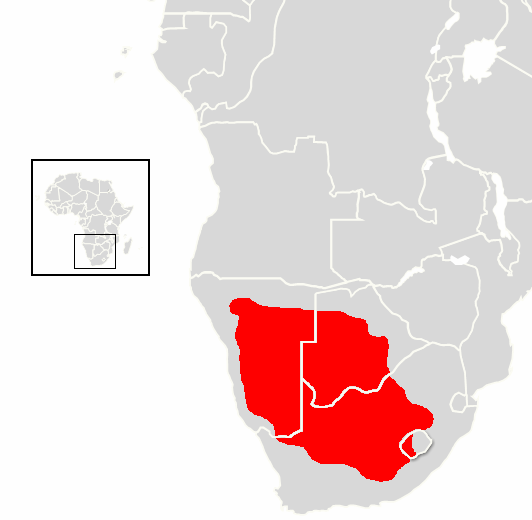
Behavior and ecology
Cape ground squirrels live mainly in arid or semiarid areas. They prefer to live invelds and grasslands with hard ground. They can also be found in scrub along pans, on floodplains and in agricultural areas. Ground squirrel are generally active during the day and do not hibernate. They are burrowing animals that dig and live in clusters of burrows averaging around 700 square metres (7,500 sq ft) with 2-100 entrances. Burrow serve to protect the squirrel from extreme temperatures at the surface as well as predators. Nevertheless most of the day is spent feeding at the surface. For thermoregulation, ground squirrels shade their head and back with their bushy tails.] Dust bathing is also done. Ground squirrels eat bulbs, fruits, grasses, herbs, insects and shrubs.[2]They do not hoard food so foraging is a daily activity. The Cape ground squirrel usually doesn't have to drink and it gets moisture from the food it eats. A ground squirrel’s daily activities are made of around 70% feeding, 15-20% being vigilant and around 10% socializing. The burrows of Cape ground squirrels are also used by meerkats and yellow mongooses. While Cape ground squirrels and meerkats appear to have a mutual relationships, mongoose and squirrel relations appear to be more commensal. Predators of grounds squirrels include jackals, snakes and monitor lizards. Ground squirrels may be able to scent the differences in the dropping of predators and non-predators. When threatened by predators, like snakes, ground squirrel will engage in mobbing behavior. Multiple squirrels will rush at the predator while using their bushy tails to block it. When the predator strikes back, all the squirrels back off. However, multiple mobbings are generally successful in driving anyway predators.
Communication
When perceiving something at a threat, ground squirrels will emit a whistle-like call as an alarm call. The alarm call comes in two forms; the short by shrill "bi-jo" which signal serious danger, and a medium-pitched "bi-joo" sound with is used for lesser dangers. During agonistic encounters, squirrels emit deep growls as signs of aggression. Juvenile squirrels make play calls, nest-chirpings, and protest squeaks.
Reproduction
Cape ground squirrel mate and reproduce year-round but mating occurs mostly in dry winter months. Since females copulate with multiple males, the males' large testes are useful for sperm competition. After copulation, males will masturbate which could serve to keep the genitals clean and reduce the risk of sexually transmitted infections. In groups, only one females at a time enters estrous which lasts around three hours. Gestation lasts around 48 days or 42–49 days. Lactation begins not long before the pups are born. A lactating female isolates herself in a separate burrow to care for their young but she returns to her group after weaning or if her litter is lost for some reason.[2] There are 1-3 pups in a litter. They are born altricial, hairless and blind. The pups stay in the burrows for their first 45 days. By 35 days, the eyes are open. Seven days after emerging from the burrows, the pups can eat solid food. Lactation ends at around 52 days. Males reach sexual maturity at eight months while female mature at 10 months. The former leave their natal groups while the latter remain.
and the
Tree Squirrel or Smith's Bush Squirrel [Paraxerus cepapi]
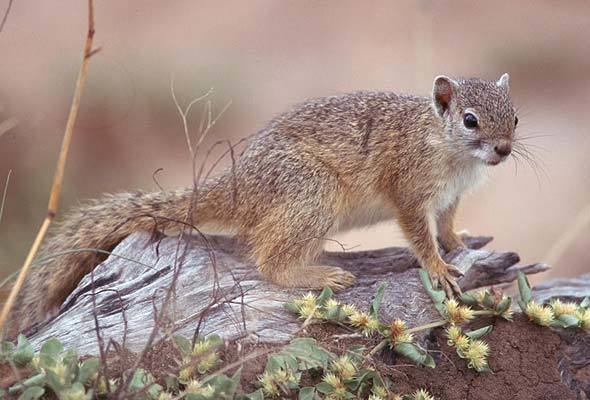
Appearance
The total length is 350 mm, half of which is tail. This species only weighs 200 gram. The coat colour varies throughout the region. In the western and arid parts of its range it is pale grey, and in the eastern localities more brown. Head and legs are a rusty colour. Colouration on the chest varies from yellowish to buffy in the east, to white in the west. The Tree Squirrels' bellies are white. These alert and ever busy creatures carry their long tails extended backwards.
Diet
Primarily vegetarian, but like most rodents will take insect prey. Tree squirrels use their forefeet to manipulate food items when feeding. They scatter-hoard seeds next to tree trunks or grass tufts, thereby facilitating tree regeneration.
Breeding
In southern latitudes they are seasonal breeders. Courtship and mating occurs during August. They give birth to one to three pups during October to November, after a gestation period of 56 days. Pups are weaned at six weeks and leave the nest to feed on its own at the age of only 19 days.
Social Behaviour
Essentially arboreal animals, but spend a great deal of time on the ground, foraging for food. When disturbed, Tree Squirrels will always seek the refuge of trees. During the night, territorial family groups nest together in holes in trees. Offspring become sexually mature between six to nine months, at which stage they are forcibly evicted by the breeding pair. The males are mainly responsible for territorial defense, although females will also chase intruders when she cares for dependent pups. To promote group cohesion, a common scent is shared by mutual grooming, which is an important facet of the social fibre of this species.
Habitat
Inhabits savanna woodlands, inclusive of a wide variety of woodland types. It favoures trees with suitable holes for nesting, such as mopane. Failing the availability of nesting crevices in trees, will sometimes use holes in the ground.
Where they are found
The southern limit of this rodent's distribution in South Africa, extends into the woodland savanna regions of North Western, Northern and Mpumalanga Provinces, and from here eastwards to Swaziland and Mozambique.
And then of course the famous chipmunks

But they only live in Disneyland





